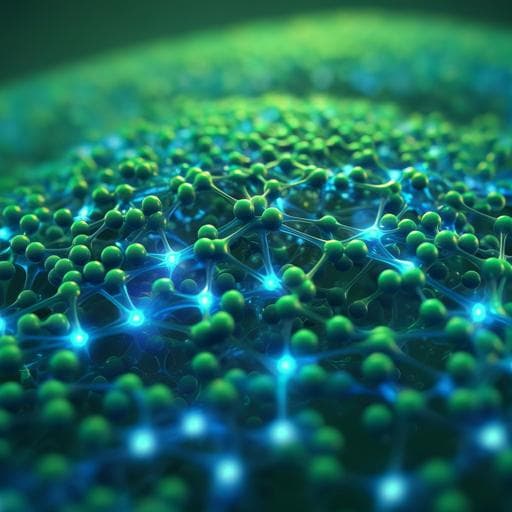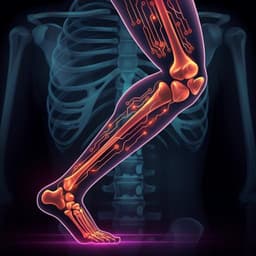
Medicine and Health
Polyphenol-mediated redox-active hydrogel with H₂S gaseous-bioelectric coupling for periodontal bone healing in diabetes
X. Fang, J. Wang, et al.
Discover a groundbreaking hydrogel developed by Xinyi Fang and colleagues that overcomes the challenges of diabetic periodontitis by enhancing tissue regeneration. This innovative material, which integrates anti-inflammatory properties and promotes mesenchymal stem cell function, successfully reverses the hyperglycemic inflammatory microenvironment, paving the way for advanced periodontal treatments.
~3 min • Beginner • English
Introduction
Periodontitis is an infection-driven inflammatory disease that damages periodontal tissues and can lead to tooth loss. Diabetes mellitus exacerbates the severity of periodontitis by dysregulating both innate and adaptive immune responses, increasing oxidative stress and inflammation, and impairing mesenchymal stem cell (MSC) function. Conversely, inflammatory mediators from periodontitis can worsen glycemic control and diabetic complications. Conventional therapies (scaling and root planing, regenerative surgery, antibiotics and/or bioactive molecules) and commonly used guided bone/tissue regeneration (GBR/GTR) membranes are limited in diabetic settings due to persistent oxidative stress, excessive inflammation, and compromised MSC function. Endogenous cues such as bioelectric, mechanical, and gaseous signaling orchestrate healing. Hydrogen sulfide (H₂S), an endogenous gasotransmitter, modulates inflammation, ROS, apoptosis, angiogenesis, and osteogenesis, but its biosynthesis is impaired in diabetes. Exogenous H₂S donors suffer from burst release and poor solubility. Bioelectricity regulates cell behaviors, bone growth/remodeling, and cell alignment critical for functional periodontium, yet traditional GBR/GTR membranes lack conductivity to transmit endogenous signals. Hydrogels are attractive ECM-mimetic scaffolds, but safety and biofunctionality concerns limit common conductive fillers. Polyphenols (e.g., polydopamine, PDA) offer redox activity, biocompatibility, antioxidation, and immunomodulation, and can hydrophilize conductive components for uniform dispersion. This study aims to engineer a polyphenol-mediated redox-active conductive hydrogel with sustained H₂S release to couple gaseous and bioelectric signals, reverse the hyperglycemic inflammatory microenvironment, and promote integrated periodontal regeneration in diabetic periodontitis.
Literature Review
Current periodontal regeneration approaches combine mechanical debridement with regenerative surgery and localized delivery of antibiotics/growth factors, but outcomes are hindered in diabetes by heightened oxidative stress, inflammation, and impaired MSC function. GBR/GTR membranes serve as physical barriers; newer biologically active versions still face limited efficacy in diabetic inflammatory conditions. Endogenous H₂S supports anti-inflammatory, anti-oxidative, pro-angiogenic, and osteogenic processes; however, diabetes reduces H₂S biosynthesis, impairing MSC recruitment and angiogenesis. Existing H₂S donors (inorganic sulfide salts, GYY4137, DTTs) often show rapid, uncontrollable release and poor solubility, hampering therapeutic benefit. Bioelectricity influences migration, proliferation, differentiation, and bone remodeling; conductivity is needed to transmit endogenous signals but typical conductive fillers (ionic liquids, conductive polymers, carbon/metal nanoparticles) can pose safety, aggregation, or limited biofunctionality issues. Polyphenols such as tannic acid, pyrogallol, gallic acid, and dopamine have catechol/pyrogallol groups enabling redox activity, antioxidation, immunomodulation, and improved dispersion of conductive components, suggesting a path to safe, multifunctional conductive hydrogels.
Methodology
Design and materials: A dual-crosslinked alginate/gelatin (AG) hydrogel was engineered to couple endogenous electrical and gaseous signals by incorporating (i) conductive poly(3,4-ethylenedioxythiophene)-assembled polydopamine-mediated silk microfibers (PEDOT-PSF) and (ii) a sustained H₂S release system comprising NaHS-loaded bovine serum albumin nanoparticles (BNPs).
- PEDOT-PSF fabrication: Silk cocoons were degummed, and micro-silk fibers (mSF) were polydopamine-coated via a PDA-assisted protection-extraction process to yield PSF. In situ PEDOT assembly was achieved by dispersing PSF with EDOT monomer and FeCl₃·6H₂O in EtOH/H₂O (3:1) for 3 h, followed by washing and drying.
- NaHS@BNP synthesis: BSA aqueous solution was mixed with an ethanol solution of NaHS via controlled addition (0.5 mL/min). EDC was added to crosslink BNPs, stirred 12 h, then nanoparticles were collected by centrifugation.
- Hydrogel preparation: Gelatin (0.8 g) was dissolved in 10 mL of 2 wt% sodium alginate at 65°C. PEDOT-PSF (0.02 g) and BNPs (0.01 g) were dispersed, followed by PEGDE (600 µL) for gelatin crosslinking (24 h). Hydrogels were then ionically crosslinked in 5% CaCl₂ for 1 h to crosslink alginate. Control groups included AG, PSF-AG, BNP-PSF-AG, and PEDOT-PSF-AG.
Characterization:
- Morphology/structure: SEM imaged mSF, PSF, PEDOT-PSF, NaHS@BNP, and hydrogel microstructures; EDS mapped elemental S on PEDOT-PSF. XRD/FTIR supported PEDOT assembly on PSF.
- Redox activity: XPS O1s spectra quantified C–O and C=O contents in PSF, PEDOT-PSF, and H₂S-treated PEDOT-PSF to assess catechol-quinone balance and PEDOT-to-PDA electron transfer; H₂S protection of catechols was evaluated.
- H₂S release: Hydrogels were incubated in PBS (37°C); H₂S release quantified using a commercial H₂S assay kit, tracking sustained release over time.
- Mechanics: Compressive and tensile testing (Instron 5567); cyclic compression up to 80% strain to evaluate resilience; degradation profiles assessed.
- Conductivity: Two-probe electrochemical measurements (CHI 660) on cylindrical samples; LED circuit tests under compression/recovery to evaluate dynamic conductivity; stability assessed during deformation and in vivo.
In vitro biological assays:
- PDLSC culture: Human PDLSCs (passages 2–4) under high glucose/inflammatory conditions (33 mM glucose, 100 µg/L LPS) seeded on hydrogels; high-throughput electrical stimulation (ES) at 0, 300, 600 mV for 30 min/day for 3 days; proliferation (MTT), morphology (phalloidin staining), aspect ratio, osteogenic markers (qPCR for ALP, OCN), and ALP activity measured; intracellular Ca²⁺ assessed via Fluo-8 AM and flow cytometry; migration by scratch assay.
- Antioxidation: DPPH radical scavenging assay for hydrogels; intracellular ROS in THP-1 macrophage-like cells via DCFH-DA staining/flow cytometry; THP-1 viability (MTT) and live/dead staining.
- Immunomodulation: THP-1 polarization on hydrogels under high glucose/LPS; quantification of M1 (CD86) and M2 (CD206) by flow cytometry and immunofluorescence (iNOS/CD68 and CD163/CD68); macrophage polarization-related gene expression; osteoclastogenesis assays in RAW 264.7 with RANKL (TRAP, NFATC1, CTSK, c-FOS).
- Transcriptomics: RNA-seq of PDLSCs on PSF-AG, PEDOT-PSF-AG, BNP-PEDOT-PSF-AG under high glucose/LPS and ES (600 mV) for pathway analysis (osteogenesis, migration, angiogenesis, ROS metabolism, autophagy). RNA-seq of THP-1 on AG, PEDOT-PSF-AG, BNP-PEDOT-PSF-AG for immune/lipid metabolism pathways and GSEA of lipid biosynthesis/catabolism and GPx activity.
In vivo studies:
- Diabetic periodontitis rat model: Male SD rats received STZ (55 mg/kg i.p.) to induce diabetes; after 1 week, ligature-induced periodontitis for 4 weeks. After flap elevation, hydrogels (3×2×0.5 mm³) implanted; animals sacrificed at 7 and 28 days.
- Outcomes: Oxidative stress indices (GSH/GSSG ratio; GPx activity) in defect tissue; immunofluorescence for M1 (iNOS/CD68) and M2 (CD163/CD68); TRAP staining for osteoclasts; PDLSC recruitment (CD90), angiogenesis (CD31, α-SMA) at day 7; osteogenesis markers (RUNX2, OCN) at week 4; micro-CT for BV/TV and RF-ABC distance; histology (HE) and Masson’s trichrome for bone maturation (mature bone/osteoid ratio); PDL fiber angulation quantification.
Statistics: Two-tailed t-tests for two-group comparisons; one-way ANOVA with Tukey–Kramer for multiple groups; mean ± SEM; P<0.05 considered significant.
Key Findings
Material characterization and properties:
- PEDOT assembled on PDA-coated silk microfibers (PSF) was confirmed by SEM, EDS (S element on PEDOT-PSF), XRD/FTIR. NaHS@BNPs were spherical (~300 nm).
- Redox-active system demonstrated by XPS: C–O (catechol) increased from 31.71 ± 8.28% (PSF) to 57.60 ± 3.88% (PEDOT-PSF) with concomitant C=O decrease, indicating electron transfer from PEDOT to PDA; H₂S treatment further increased C–O to 64.39 ± 1.24% and decreased C=O to 35.61 ± 1.24%, protecting phenols from oxidation.
- Hydrogel microstructure remained uniformly porous with embedded PEDOT-PSF and BNPs; PSF densified network structure.
- Sustained H₂S release from BNP-PEDOT-PSF-AG for up to 21 days.
- Mechanics: Compressive strength increased from ~82 to ~100 kPa with PSF/PEDOT-PSF reinforcement; excellent elastic recovery over 10 compression cycles; slowed degradation.
- Conductivity increased with PEDOT-PSF content, reaching 13.12 ± 1.66 S/m at 2 wt% (used thereafter). LED remained lit during compression/recovery; conductivity stable during deformation and maintained in vivo at 14 days.
In vitro biological performance:
- PDLSC proliferation and adhesion were not impaired; ES enhanced elongation on conductive hydrogels (aspect ratio increased from 3.04 ± 0.16 without ES to 4.93 ± 0.45 at 600 mV on BNP-PEDOT-PSF-AG).
- Osteogenic markers increased under ES: OCN and ALP mRNA and ALP activity were highest on BNP-PEDOT-PSF-AG vs PEDOT-PSF-AG, PSF-AG, and AG, showing synergistic effects of conductivity and H₂S.
- PDLSC migration was highest on BNP-PEDOT-PSF-AG, consistent with H₂S-mediated chemotaxis.
- Transcriptomics of PDLSCs revealed enrichment in positive regulation of migration, angiogenesis, ROS metabolism, and osteoblast differentiation; GSEA showed decreased inflammation and increased autophagy. Autophagy-related genes ATG2B and ATG12P1 were upregulated while SQSTM1 was downregulated on BNP-PEDOT-PSF-AG.
- Intracellular Ca²⁺ influx significantly increased in PDLSCs on BNP-PEDOT-PSF-AG under ES (flow cytometry), linking conductivity to osteogenesis.
- Antioxidation: DPPH radical scavenging increased over time for all PSF-containing hydrogels; BNP-PEDOT-PSF-AG exhibited the highest scavenging. THP-1 intracellular ROS was lowest on BNP-PEDOT-PSF-AG with preserved cell viability.
- Immunomodulation: Relative to AG, PSF-containing and conductive/hydrogen-sulfide-loaded hydrogels reduced M1 polarization and, notably, BNP-PEDOT-PSF-AG increased M2 polarization the most; osteoclastogenic gene expression and TRAP activity were reduced in PEDOT-PSF-AG and BNP-PEDOT-PSF-AG.
- THP-1 transcriptomics: BNP-PEDOT-PSF-AG downregulated lipid biosynthesis pathways and upregulated lipid catabolism and GPx activity; M1 genes decreased (PEDOT-PSF-AG and BNP-PEDOT-PSF-AG), M2 genes increased (BNP-PEDOT-PSF-AG), indicating lipid metabolism-mediated immunomodulation.
In vivo efficacy in diabetic periodontitis rats:
- Oxidative stress amelioration: GSH/GSSG ratio increased post-implantation across groups, highest in BNP-PEDOT-PSF-AG (2.82 ± 0.26). GPx levels were nearly doubled in BNP-PEDOT-PSF-AG vs AG.
- Macrophage polarization: M1 (iNOS⁺/CD68⁺) decreased markedly—blank 18.22 ± 1.62%, AG 13.24 ± 1.21%, PSF-AG lower, PEDOT-PSF-AG 4.88 ± 0.76%, BNP-PSF-AG 5.69 ± 1.26%, BNP-PEDOT-PSF-AG 1.98 ± 0.26%. M2 (CD163⁺/CD68⁺) increased—blank 1.54 ± 0.36%, AG 2.40 ± 0.54%, PSF-AG 2.47 ± 0.28%, PEDOT-PSF-AG 5.92 ± 1.16%, BNP-PSF-AG 6.56 ± 0.67%, BNP-PEDOT-PSF-AG 8.76 ± 0.90%.
- Osteoclast activity: TRAP-positive cells were lowest in BNP-PEDOT-PSF-AG, indicating strong inhibition of osteoclastogenesis.
- PDLSC recruitment and angiogenesis at day 7: CD90⁺ cells increased (PSF-AG 2.83 ± 0.46%; BNP-PSF-AG 5.43 ± 0.46%; PEDOT-PSF-AG 4.61 ± 0.53%; BNP-PEDOT-PSF-AG 11.11 ± 0.97%); angiogenic markers CD31 and α-SMA were highest in BNP-PEDOT-PSF-AG.
- Osteogenesis at week 4: RUNX2 and OCN expression levels were significantly elevated in PEDOT-PSF-AG and further in BNP-PEDOT-PSF-AG; BNP-PSF-AG also surpassed AG.
- Bone regeneration: micro-CT BV/TV (%) increased—blank 57.54 ± 1.71, AG 60.17 ± 3.28, BNP-PSF-AG 77.50 ± 1.56, PEDOT-PSF-AG 84.25 ± 4.52, BNP-PEDOT-PSF-AG 90.35 ± 3.18. RF-ABC distance improvements paralleled BV/TV gains.
- Bone maturation: Masson’s mature bone/osteoid ratio—AG 0.44 ± 0.07, PEDOT-PSF-AG 1.00 ± 0.14, BNP-PEDOT-PSF-AG 1.94 ± 0.21.
- Functional PDL organization: PDL fiber angles—AG 17.84 ± 3.31°, PEDOT-PSF-AG 30.20 ± 1.65°, BNP-PEDOT-PSF-AG 42.65 ± 3.65°, approaching native mature angulation (48.21°).
Overall, the hydrogel’s synergistic conductivity, redox activity, and sustained H₂S release reversed the hyperglycemic inflammatory microenvironment, promoted MSC recruitment, angiogenesis, osteogenesis via autophagy and Ca²⁺ influx, modulated macrophage polarization through lipid metabolism, inhibited osteoclastogenesis, and enabled integrated periodontal regeneration.
Discussion
The study directly targets key barriers to periodontal regeneration in diabetes—excess oxidative stress, chronic inflammation, immuno-dysregulation, and compromised MSC function—by integrating three coordinated functions into a single hydrogel: PEDOT-PSF-mediated conductivity, polyphenol-driven redox activity, and sustained H₂S delivery. Conductivity enabled coupling of endogenous bioelectricity, enhancing PDLSC elongation/alignment and Ca²⁺ influx, both linked to osteogenic differentiation and functional PDL fiber organization. The PDA-based catechol-quinone redox balance, reinforced by electron transfer from PEDOT and reducing action of H₂S, enhanced ROS scavenging, restoring redox homeostasis in vitro and in vivo (elevated GSH/GSSG and GPx). H₂S release recruited PDLSCs, promoted angiogenesis, and further supported osteogenesis. Immunomodulatory effects were achieved by shifting macrophage polarization from M1 to M2 states, mechanistically associated with downregulated lipid biosynthesis and upregulated lipid catabolism and antioxidant defenses, thereby curbing osteoclastogenesis. Collectively, these mechanisms synergistically improved the periodontal microenvironment and resulted in significant gains in bone volume, bone maturation, and PDL functional alignment in a diabetic periodontitis model. The work demonstrates that coupling gaseous and bioelectric endogenous signals via a redox-active, conductive hydrogel can overcome diabetes-aggravated impediments to tissue regeneration.
Conclusion
A polyphenol-mediated redox-active alginate/gelatin hydrogel incorporating conductive PEDOT-PSF microfibers and NaHS@BSA nanoparticles for sustained H₂S release effectively reversed the hyperglycemic inflammatory microenvironment and promoted integrated periodontal regeneration in diabetic periodontitis. The hydrogel exhibited robust mechanics and dynamic conductivity, long-term H₂S release, strong antioxidative and immunomodulatory functions, enhanced PDLSC recruitment and angiogenesis, inhibited osteoclastogenesis, and boosted osteogenesis via autophagy activation and Ca²⁺ influx, yielding superior bone formation, bone maturation, and PDL fiber alignment. This gaseous-bioelectric coupling strategy offers a promising design paradigm for biomaterials aimed at functional tissue regeneration in immune-related diseases. Future work could explore long-term safety and degradation behavior, optimize dosing and release kinetics of H₂S, assess scalability and manufacturability, and evaluate efficacy across larger animal models and eventual clinical translation.
Limitations
Related Publications
Explore these studies to deepen your understanding of the subject.







